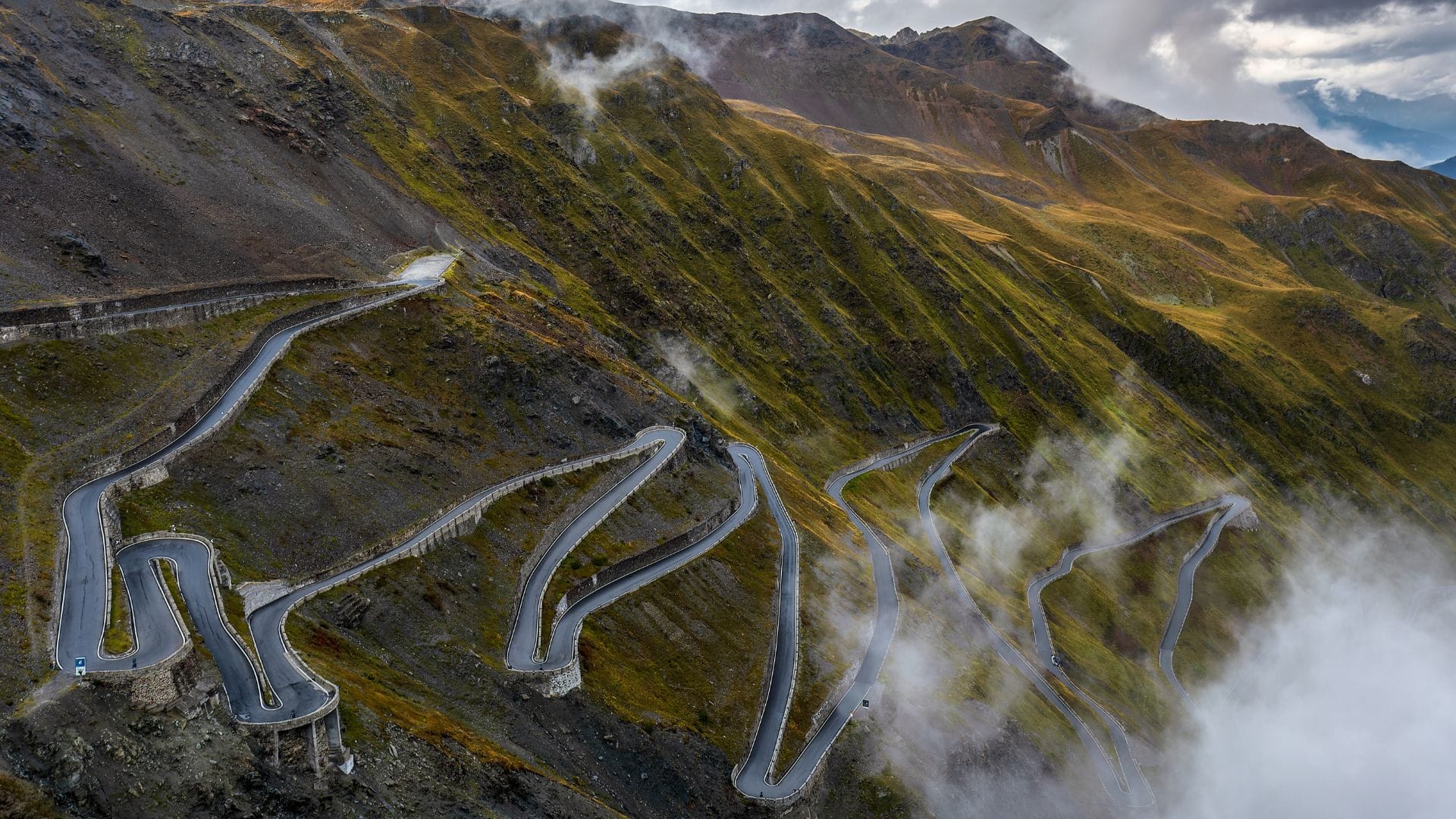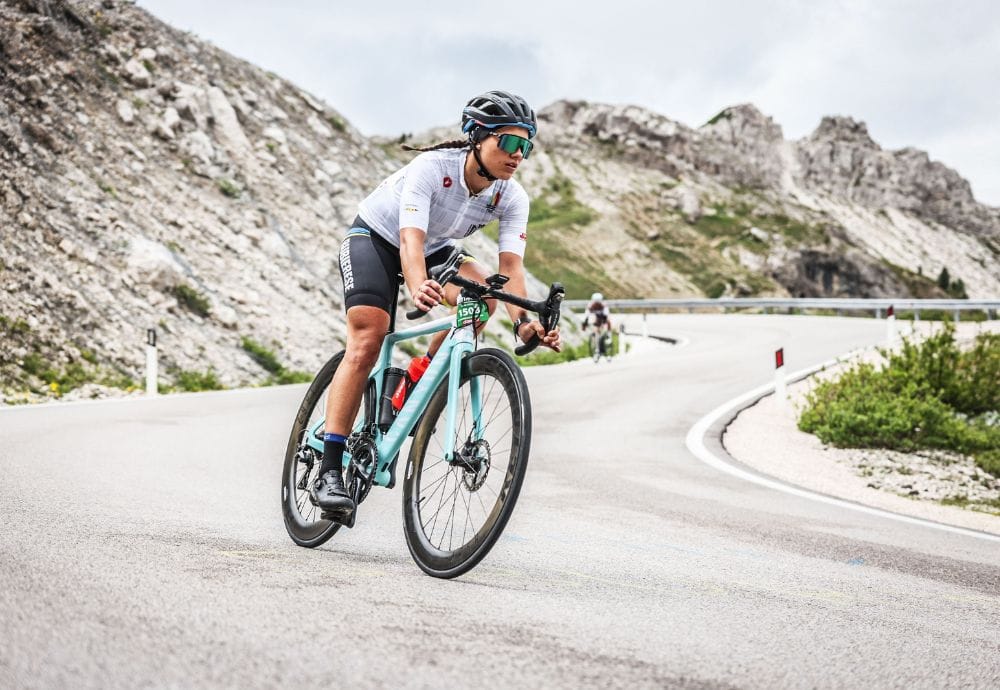Descending like a boss: Mastering Italy's Hairpin Turns and Mountain Roads
In this article, Landry Bobo shares his top tips for safe and fast descents while cycling in the Dolomites or other mountainous areas.

When you watch a major stage race, like the Giro d'Italia or Tour de France, it's impressive how fast they go uphill. The best riders climb exceptionally quickly! A 6 w/kg FTP is something that us mere mortals can't fathom.
However, what's equally impressive is how fast the pros go DOWN these climbs. Riders will reach speeds of close to 100 kph, dive bomb straight into corners, and dodge broken pavement seemingly unfazed. As a casual viewer, it can be quite hair-raising to watch.
If you have never ridden down a mountain descent with sharp bends, steep inclines, and blind corners, it can be scary. Even experienced cyclists can feel nervous when first tackling a switchback descent in Northern Italy such as the Passo dello Stelvio.

Luckily, going downhill is easy to improve. Once you practice, it even becomes fun. It is honestly one of the best parts of cycling in Italy and a crucial skill to fully appreciate those bucket list climbs.
In this article, we will share our best tips for safe and fast descents while cycling in the Dolomites or other mountainous areas.
Mindset
The most important part of descending effectively on your bike is your mind. To descend effectively, you must enter into a calm flow state. Essentially, you will be so in tune with your bike that you won't even be thinking about descending. It will come naturally.
I know I've had days where for some reason I can't descend as well. Nothing changed with my skill set or technique, but mentally I was not all there. I might have distracted myself thinking about what I need to do when I get back. Or maybe I was just tired from a bad night's sleep.
Yet, there are also those days where it seems automatic. I'm taking perfect lines, riding down the mountains safely, staying calm and maybe even nabbing a few PRs as well!
To enter into this mindset you have to not think. This sounds counterintuitive, but if you think too much about descending, you can lose fluidity and psych yourself out. Instead, just focus on the road ahead of you and the line you will take. The more practice you get with descending on your bike, the easier it will become to enter into this zen-like state when riding down the famous mountain passes of Northern Italy.
One thing that profoundly helps is also deep breathing while descending. We might be used to taking more rapid breaths when going uphill, but we should practice taking deep breaths while descending. This will naturally calm your body and mind.

Technique
Once your head is in the right place, you can then start perfecting your descending technique. Descending is not too hard once you understand it. If you do these few things right, riding in the Dolomites will be easy!
Look Ahead at Where You Want to Go
A common mistake while descending is looking at the road directly in front of you. This is our natural tendency because we want to make sure there's nothing blocking our path. The problem with this is that you can't judge the corner in front of you and anticipate what's coming next.
When you travel at high speeds, things happen quickly. If you only look right in front of you, you won't have enough time to avoid fast-approaching obstacles or corners.
Looking further up the road gives you more time to make a decision. If you see a pothole, it gives you time to adjust your line and maneuver around it. If it's a tricky corner, you have more time to decide which line you will take.

Cut the Apex
If you've ever watched Formula 1 or any other motorsport, you'll already know what this looks like. The fastest way to round a corner is to take it wide, and cut the apex.
However, this isn't exactly the same for every corner. A sharper corner will require you to go wider and scrub off speed before rounding in tightly and cutting the apex. For a more shallow S-bend, you won't have to go nearly as wide, nor will you have to cut the apex as sharply.
If you have back-to-back corners, you also need to think about how the current corner will line you up for the next one. You might need to take the first corner a little bit tighter to set yourself up well for a subsequent hairpin.

To prepare for different situations, the best way is to watch a professional bike race. Each descent has a lot of variability. If you can't easily find places to practice, this is the best way to learn how to turn your bike when riding in the mountains.
Brake Before the Turn
If the corner is sharp and needs a lot of braking, you should brake mostly before entering the curve. One reason for this is that if you don't slow down before turning, you might slide out. You could also mess up your line while going around the bend.
You have likely seen this in a pro bike race. A rider misjudges a turn and does not slow down enough. Making corrections mid-turn is pretty hard if you already going too fast.
If you brake before a sharp turn, you can let off the brakes as you enter it. This helps you gain speed as you go around the corner. You will have a higher exit speed. This is the fastest way to descend when riding those switchback descents so common in Italy!
Now, in the middle of a corner, you can make small adjustments if you need to slow down more. However, you should do 90% of your braking before you enter a corner.
Feet Placement
This is one of the most important pieces to descending on your bike. When descending, you will bend the knee in whatever direction you are turning, while firmly planting the other leg straight down. So for a right turn, your right foot would be elevated and your left foot will be planted.
Lifting your inside foot will prevent your feet from hitting the ground when turning sharply. You will simultaneously straighten out your outside leg and plant your foot. Push down into the ground with your outside foot. This will help you stay stable when turning a sharp corner.

Stay Loose
One final thing to be mindful of is to keep your body relaxed while descending. If your body is rigid and locked up, it will be more difficult to maneuver the bike. Additionally, you will feel the vibrations in the road more intensely if you lock your arms. Keep your body loose and relaxed while descending on your bike – and have fun!

Equipment
Now that your technique and mindset are dialed in, make sure you have the right equipment. This way, you can enjoy the descents in style on your cycling trip in Italy.
The most important piece for descending is your tire selection and pressure. Investing in a good quality set of tires is well worth the money for descending. Look for "race" tires such as the Continental GP5000 or Vittoria Corsa. These types of tires offer superior grip and comfort.
Another thing to keep in mind is your tire width. Long gone are the days of skinny 21mm tires! Wider tires let you use lower tire pressure. This gives you better control on winding mountain descents. If you can fit them, 28 or 30mm tires are amazing for descending on your bike.
Lastly, you also want to make sure you have the correct tire pressure. If your tire pressure is too high, you won't grip the road well. Lower tire pressure can actually improve rolling resistance. A heavier rider needs more tire pressure than a lighter rider. Generally, a good range is between 55-70 psi. This is for tires that are about 28mm wide. There are plenty of charts online to help you calculate the ideal tire pressure.
Good eyewear is also crucial for descending. You want sunglasses with great visibility and the correct lenses for whatever conditions you are riding in. Keep an eye on the forecast for the day as well. If it's expected to be rainy or cloudy, I would definitely recommend swapping for light/clear lenses to help with visibility when riding in the mountains.
Practice
The best way to get better at descending is, of course, to go out and descend! If you can find any curvy mountain roads nearby, this is the best way to gain confidence for a cycling trip to the Dolomites.
Another great way to improve descending on your bike is by watching pro bike racing on television. This is what significantly helped me early on with both my climbing and descending technique for riding in the mountains of Northern Italy.
Descending in a Group
Some of the trips offered by CyclingHero include mass-start events like the Maratona dles Dolomites or the Etape Parma. For these events you have the additional challenge of descending while surrounded by many other cyclists. This can be intimidating, especially when you get more confident riders whooshing past you.
But you will be fine if you follow these key suggestions:
- Go with the flow: sync with the riders around you and make slow, deliberate movements, rather than darting around the road.
- Leave some space in front: You’ll see that even pro riders will leave some distance to the rider in front of them when descending at higher speeds. This allows you time to react to any changes in direction or pace by the rider in front, and lets you see the road better.
- Watch your line: If you have riders on either side of you coming into a bend, you may not want to follow some of the above advice on cutting the apex, but rather just follow the general line of the riders on either side of you.
- Be patient. Later in the event you will have the opportunity to optimise your cornering once the group thins out.

Avoid Zip-gate and other safety considerations
It's often quite cold on the passes, even in the summer. You should have already packed a windbreaker with you even on a sunny day, especially if you sweat a lot.
Although it can be tempting to try to put your jacket on while still riding, it's best to pull over and do it stationary before the downhill starts. Trying to get a crumpled up jacket on with numb hands while trying to keep at least one hand on the bars is often an exercise in futility, and can be quite dangerous, especially if your jacket ends up in your rear wheel. Even the pros can have trouble with this.
This applies even more so when you are riding in a group. Signal you are pulling over, gradually come to a stop at the side of the road, and get that jacket out calmly and safely.
And it goes without saying that if you are riding on open roads, don't cut into the other lane when taking the corners unless it is 100% certain no one is coming up the other way. Often the road is not in as good condition near the center line, anyway.
Getting faster both up and down the climbs
If you want some support and structure while preparing to ride the climbs of Northern Italy, reach out to us at Evoq. We have a great team of coaches who can help you improve in all aspects of your riding and make your upcoming cycling trip to the mountains that much more enjoyable.
Hit us up here and schedule a free discovery call. See you on the climbs (and descents!).

Comments ()